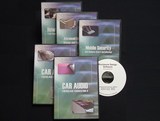Questions and Answers
We have four questions that mainly relate to power capacitors and multiple amp systems (two topics).
Q1: "Is there any trick to wiring TWO amps to one capacitor"
A1: No, there isn't any trick to wiring two amps to one capacitor. Here's how you'd wire it all up.
- Run one power wire, large enough to effectively carry the current load of both amplifiers, to your amp rack. Fuse this wire as close as practical to the battery with a fuse capable of carrying the current required by both amplifiers (add your amplifier fuse values together to get the total fuse size needed). This fuse is to protect the main power wire (and your vehicle in case of a direct short).
- Connect the other end of this main power wire to the positive terminal of your capacitor. Connect the negative terminal of the capacitor to ground. NOTE: The capacitor should be mounted as close as possible to your amplifiers.
- Connect the positive terminal of each amplifier to the positive terminal of the power capacitor.
Q2: "I was reading your article (on installing a power capacitor) and a few others and instead of using a resistor I was told a test light would work."
A2: A test light will also work because of its internal resistance. Either way is fine. If using a test light to charge a power capacitor you follow these steps.
- Connect the capacitor negative terminal to ground
- Connect the test light between the capacitor positive terminal and +12 volts
- When the test light goes out the capacitor is charged
Q3: "I was wondering if you could tell me exactly what wire it is that I run my remote wire from amp to the factory radio. I had power once just want a little insight on this from a professional."
A3: Your factory radio probably doesn't have a remote wire since most factory radios have their amplifiers built in and don't need a remote wire. It may have a power antenna wire but that will only work when the radio is on and not the CD/tape. The poor man's method is to wire the remote terminal from a switched +12 volt source. Either wire it to the ignition +12 volt or wire it to a switch. Wiring it to the ignition +12 volt will turn the amplifier on every time the car is running, even if the radio is off. You could wire in a simple switch that would allow you to turn the amp on or off via that switch. It would just be connected to either constant or ignition +12 volts and would have the ability to be turned off if desired. There are also units that will sense the voltage on the factory speaker wires and then send a +12 volt signal to the remote wire.
Q4: "I am installing two amps in my ford ranger. Would it be easier to run two separate power cables or is it better to run one large cable then go to a distribution block then to the amps? Also for the ground should they both be grounded to the same spot or to two different bolts? I have read on different sites stating two spots is best and others saying same spot is best."
A4: I would run one wire in a multiple amplifier wiring situation for several reasons.
- It's usually cheaper than two wires
- It's easier to run one wire
- You only have to make one connection at the battery
- You only need one fuse holder near the battery
I use a regular distribution block, not the fused kind. They're cheaper and there's no need for the extra fuses when there is already a fuse holder near the battery that protects the main power wire (you'll have to install this fuse holder). Some amplifiers do not have internal fuses (rare) and these will benefit from a fused distribution block.
I ground my components using separate ground points and I think others should too. I could go into all of the scientific reasons for this but it all boils down to noise. Not to say that either way is a sure way to eliminate noise but it helps if the ground points are separated by at least six inches or so. That's been my experience but your mileage may vary. Whatever works, works.

The Car Audio Help DVD catalog includes five different videos covering many areas of car audio installation and custom fabrication. Topics range from basic system installation (head units, amplifiers, speakers, etc.) and mobile security (car alarms and remote start) to subwoofer box design and fiberglass fabrication. If you're interested in custom fabrication and car audio installation be sure to check out what we have to offer.
Click here to see the discount DVD packages
Back to the Newsletter Archives Index